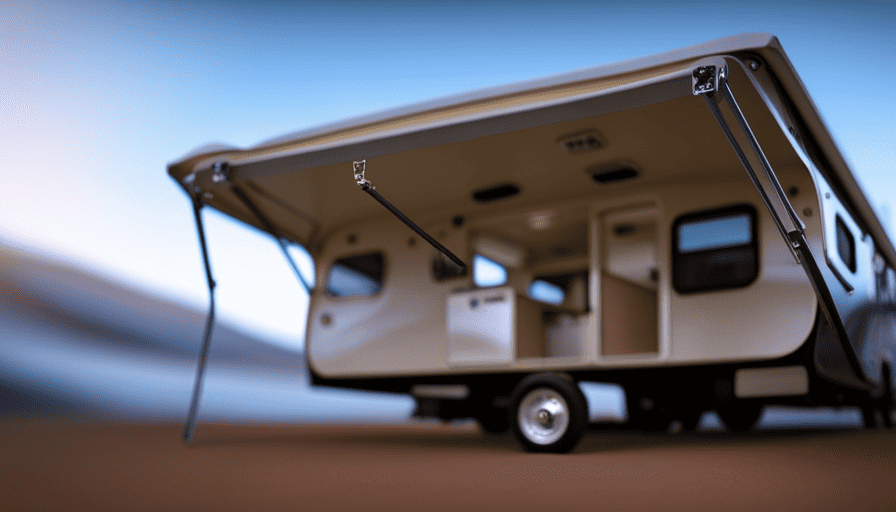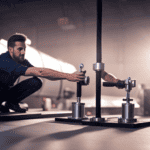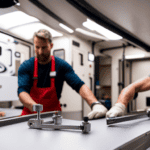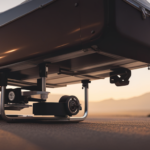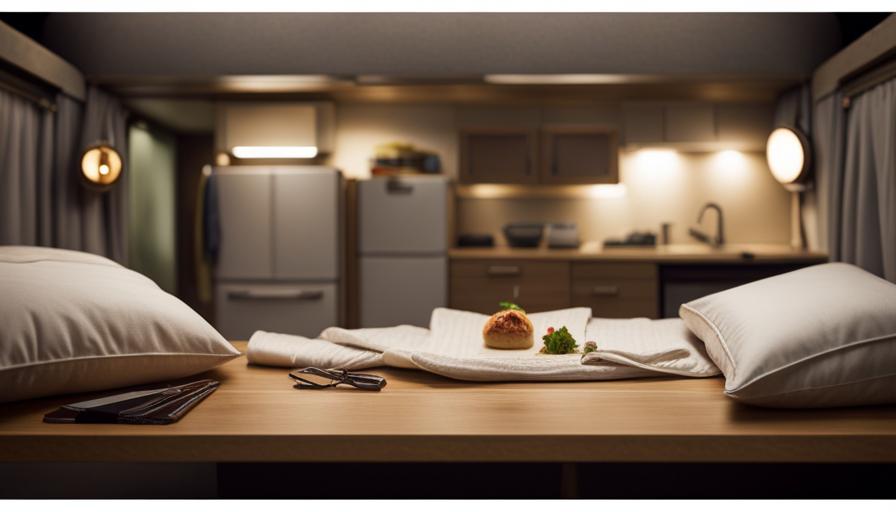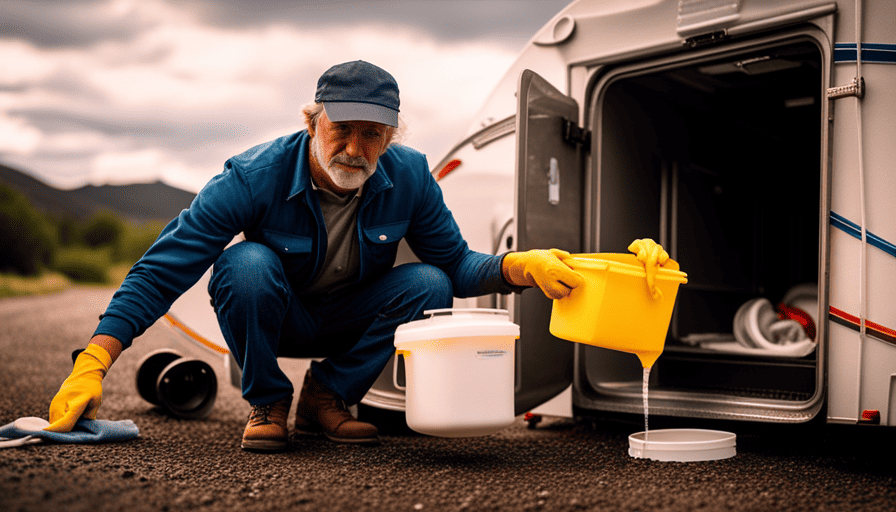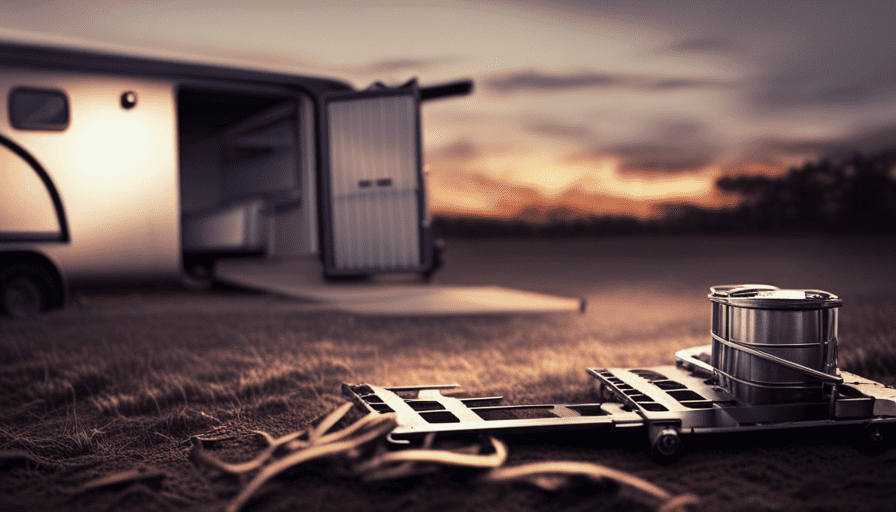Have you ever been curious about the workings of a pop-up camper lift system?
Well, let me lift the veil of mystery and take you on a journey into the inner workings of this fascinating mechanism. Like a spider weaving its web, the lift system intricately connects various components to effortlessly raise and lower the camper with ease.
At its core, the lift system relies on a combination of cables and pulleys to achieve its lifting prowess. These components work in perfect harmony, creating a mechanical advantage that allows even the most petite of individuals to effortlessly raise the camper roof.
But it doesn’t stop there. There are different types of lift systems, each with its own unique design and functionality. From the classic Goshen lift system to the innovative Winnebago lift system, there’s a wide range of options to choose from.
In this article, we’ll explore the inner workings of a pop-up camper lift system, the role of cables and pulleys, how it supports the weight of the camper, and much more.
So, buckle up and get ready to dive into the world of pop-up camper lift systems!
Key Takeaways
- Pop-up camper lift systems rely on cables and pulleys for raising and lowering.
- Crank, winch, and push-button are common types of lift mechanisms.
- Regular maintenance and inspection are important to ensure proper functioning.
- Upgrading the lift system can enhance safety, efficiency, and convenience.
Understanding the Basics of a Pop-Up Camper Lift System
The understanding of the basics of a pop-up camper lift system is essential for comprehending how it operates. This lift system is designed to raise and lower the camper’s roof, allowing for easy setup and storage.
At the heart of this mechanism are cables and pulleys, which work together to provide the necessary lifting force. When you activate the lift system, the cables are engaged and begin to wind around the pulleys. These cables are strategically placed to distribute the weight of the camper evenly, ensuring a smooth and balanced lift.
The pulleys, on the other hand, act as mechanical devices that redirect the force applied to the cables, allowing for a more efficient lifting process. The weight distribution in a pop-up camper lift system is crucial. If the weight is not properly distributed, it can cause the lift system to become unbalanced and potentially lead to damage or even accidents.
Therefore, it is important to follow the manufacturer’s guidelines and ensure that the weight is evenly distributed when using the lift system. Understanding the role of cables and pulleys in the lift mechanism is the first step in comprehending how a pop-up camper lift system works. It sets the foundation for understanding the more intricate details of this complex system.
The Role of Cables and Pulleys in the Lift Mechanism
Imagine yourself standing next to a pop-up camper, marveling at the intricate dance between the cables and pulleys that effortlessly hoist the roof into the air. The cables and pulleys play a crucial role in the lift mechanism of a pop-up camper. Let me break down the mechanics of how they work together:
-
Cables: These strong and durable cables are attached to the corners of the pop-up camper’s roof. They’re responsible for transmitting the lifting force from the pulleys to the roof. As the pulleys rotate, the cables are pulled, causing the roof to rise.
-
Pulleys: The pulleys in a pop-up camper lift system are strategically placed to maximize the mechanical advantage. These simple machines consist of a grooved wheel that allows the cables to move smoothly. By changing the direction of the force applied to the cables, the pulleys effectively multiply the lifting force, making it easier to raise the roof.
-
Mechanics of Lifting: As the cables are pulled by the rotating pulleys, the force is distributed evenly across the lift system. This ensures that the roof is lifted smoothly and without any strain on the cables or pulleys.
With a clear understanding of how the cables and pulleys work together, we can now move on to exploring the different types of lift systems used in pop-up campers.
Exploring the Different Types of Lift Systems
Let’s now delve into the various types of lift systems used in pop-up campers, which will keep you intrigued and wanting to learn more. There are different lift mechanisms employed in pop-up campers, each with its own set of advantages and disadvantages. These mechanisms determine how the camper is raised and lowered, and they play a crucial role in the overall functionality of the camper.
To better understand the differences between these lift systems, let’s take a look at the following table:
| Lift Mechanism | Advantages | Disadvantages |
|---|---|---|
| Crank System | Easy to use, reliable | Requires physical effort |
| Winch System | Effortless operation, precise height adjustment | More expensive, requires power source |
| Push-Button System | Convenient, quick and easy operation | Limited height adjustment, potential for electrical failure |
The crank system is the most common and basic type of lift mechanism. It involves manually turning a crank to raise and lower the camper. While it requires physical effort, it is reliable and easy to use.
The winch system, on the other hand, offers effortless operation and precise height adjustment. However, it is more expensive and requires a power source, such as a battery or electricity.
Lastly, the push-button system provides the convenience of quick and easy operation. It eliminates the need for manual labor, but it has limited height adjustment capabilities and the potential for electrical failure.
Now that we have explored the different types of lift systems, it is important to understand how these systems support the weight of the camper.
How the Lift System Supports the Weight of the Camper
Picture yourself effortlessly raising and lowering your home away from home with the simple push of a button, as if it were floating on air. This is made possible by the pop-up camper’s lift system, which provides the necessary support and stability for the camper.
The supporting structure of the lift system is typically made of heavy-duty materials such as steel or aluminum, ensuring durability and strength.
One common type of lift system used in pop-up campers is the hydraulic system. This system utilizes the power of hydraulic fluid to raise and lower the camper. When the button’s pressed, the hydraulic pump activates, forcing the fluid into the hydraulic cylinders. These cylinders, located at each corner of the camper, extend or retract, lifting or lowering the camper accordingly.
The hydraulic system is designed to support the weight of the camper evenly, distributing the load across all four corners. This ensures stability and prevents any one corner from bearing an excessive amount of weight. The lift system also incorporates safety mechanisms, such as locking pins, to prevent accidental lowering of the camper while in use.
Regular maintenance and inspection of the lift system are crucial to ensure its proper functioning. This includes checking for any signs of wear and tear, lubricating moving parts, and verifying the hydraulic fluid levels. These measures help maintain the lift system’s reliability and ensure a safe and enjoyable camping experience.
Moving on to the next section, let’s explore the importance of regular maintenance and inspection for your pop-up camper.
The Importance of Regular Maintenance and Inspection
Regular maintenance and inspection are crucial for ensuring the safety and longevity of your pop-up camper. The lift system of a pop-up camper is a complex mechanism that requires regular care to function properly. By performing routine maintenance, you can prevent common lift system issues and keep your camper in optimal condition.
One of the most important aspects of regular maintenance is lubrication. Applying lubricant to the lift system components, such as the cables, pulleys, and track, helps to reduce friction and prevent wear and tear. Additionally, inspecting the lift system for any signs of damage or loose parts is essential. Look for any frayed cables, bent pulleys, or loose bolts, as these can cause the lift system to malfunction.
Regular maintenance also involves checking the tension of the lift cables. Over time, the cables may become loose or stretched, affecting the lifting capacity of the camper. Adjusting the tension of the cables ensures that the lift system operates smoothly and efficiently.
Regular maintenance and inspection are of utmost importance to keep your pop-up camper’s lift system in good working order. By addressing any issues promptly and performing routine maintenance tasks, you can prevent common lift system problems and ensure the safety and longevity of your camper.
Moving on to troubleshooting common lift system issues, let’s discuss some common problems that may arise and how to solve them.
Troubleshooting Common Lift System Issues
Imagine you’re on the road, ready for a camping adventure, but your pop-up camper’s lift system suddenly won’t budge. It can be frustrating, but don’t worry! Here are some common lift system problems and troubleshooting techniques to help you get back on track.
-
Lack of Power: If your lift system doesn’t respond at all, check if the battery’s charged and connected properly. Test the power supply and replace any blown fuses if necessary. Also, inspect the wiring for any damage or loose connections.
-
Uneven Lifting: If one side of your camper is lifting higher than the other, it may indicate a problem with the lift cables. Inspect the cables for any fraying, kinks, or signs of wear. Lubricate the cables regularly to ensure smooth operation.
-
Struggling to Lift: If your lift system is struggling to lift the camper, it could be due to a faulty winch or pulley. Check for any debris or obstructions that may be hindering the lifting mechanism. Grease the winch and pulley regularly to prevent rust and ensure smooth operation.
By following these troubleshooting techniques, you can address common lift system problems and get your pop-up camper back in working order. Now, let’s move on to some tips for operating and using a pop-up camper lift system safely.
Tips for Operating and Using a Pop-Up Camper Lift System Safely
To safely operate and use your pop-up camper’s lift system, you should follow these essential tips.
First and foremost, it’s crucial to familiarize yourself with the safety precautions outlined in the camper’s manual. This will provide you with a comprehensive understanding of potential hazards and how to mitigate them.
Before attempting to lift the camper, make sure all stabilizing jacks are properly engaged and secure. This will prevent any unnecessary movement or instability during the lifting process.
When it comes to proper lifting techniques, it’s important to distribute the weight evenly on all four corners of the camper. This will help maintain stability and prevent any strain on the lift system. Additionally, make sure to use the correct lifting method specified by the manufacturer. This may involve using a hand crank or an electric motor, depending on the design of your camper’s lift system.
Always be mindful of your surroundings and keep a safe distance from the lift system while it’s in operation. Avoid standing or placing any body parts under the camper when it’s being lifted or lowered.
Lastly, regularly inspect and maintain your lift system to ensure its proper functioning and prevent any potential safety issues.
In the subsequent section about upgrading or retrofitting your lift system, you can explore options to enhance the safety and efficiency of your camper’s lift system.
Upgrading or Retrofitting Your Lift System
If you’re looking to enhance the safety and efficiency of your pop-up camper’s lift system, consider upgrading or retrofitting it. Upgrading your lift system can provide you with a smoother and more reliable lifting mechanism, ensuring a hassle-free camping experience. Additionally, performing regular lift system maintenance is essential to prolonging the lifespan of your camper and preventing costly repairs down the line.
To help you understand the options available for upgrading your lift system, I’ve created a table below that outlines some common upgrades and retrofits you can consider:
| Upgrade/Retrofit | Description |
|---|---|
| Electric Lift System | Replaces manual cranking with an electric motor for effortless lifting. |
| Cable Replacement | Enhances safety by replacing worn or damaged cables with new ones. |
| Gearbox Upgrade | Upgrading to a higher quality gearbox can improve lifting capacity and durability. |
| Spring Replacement | Replacing worn or weak springs with stronger ones ensures a smoother lifting process. |
| Pulley System Upgrade | Upgrading to a more efficient pulley system can make lifting easier and reduce strain on the lift system. |
By upgrading or retrofitting your lift system, you can enjoy the benefits of a more efficient and reliable lifting mechanism. In the next section, we will compare lift systems for different pop-up camper models, allowing you to choose the best option for your needs.
Comparing Lift Systems for Different Pop-Up Camper Models
When comparing lift systems for various models of pop-up campers, it’s important to consider the differences in efficiency and reliability.
One key aspect to compare is the prices of different lift systems. Electric lift systems, for example, can be more expensive than manual crank systems. However, they offer several advantages that make them worth considering.
Firstly, electric lift systems are much easier to operate. With just the push of a button, you can effortlessly raise or lower the camper. This convenience can be especially beneficial for those with physical limitations or for families with young children.
Additionally, electric lift systems tend to be more reliable and require less maintenance compared to manual crank systems. This means less time spent on repairs and more time enjoying your camping adventures.
On the other hand, electric lift systems do have some disadvantages. They rely on battery power, so if the battery dies, you may find yourself unable to raise or lower the camper. Additionally, electric lift systems can be more expensive to repair if something goes wrong.
When comparing lift systems for different pop-up camper models, it’s important to weigh the advantages and disadvantages of electric lift systems. While they may come with a higher price tag, their convenience and reliability can greatly enhance the camping experience.
Looking to the future, advancements in lift system technology will continue to improve efficiency and reliability, making camping even more enjoyable.
Future Innovations and Advancements in Pop-Up Camper Lift Systems
Now that we’ve explored the various lift systems used in different pop-up camper models, let’s take a look at what the future holds for advancements in this field. The world of pop-up campers is continuously evolving, and manufacturers are constantly working on new innovations to enhance the camping experience.
One exciting area of development is the future of automated lift systems. Currently, most pop-up campers require manual operation to raise and lower the roof. However, with advancements in technology, we can expect to see more automated systems in the coming years. These systems will utilize motors and sensors to effortlessly lift and lower the roof at the push of a button.
Here are four potential advancements in pop-up camper lift systems that we can look forward to:
- Integration with smartphone apps for remote control and monitoring.
- Enhanced safety features such as automatic leveling and stabilization.
- Improved durability and reliability through the use of high-quality materials and components.
- Quieter operation through the implementation of noise reduction technologies.
As these advancements continue to evolve, camping enthusiasts can expect a more convenient and user-friendly experience when setting up and taking down their pop-up campers. The future of pop-up camper lift systems is indeed promising, and I can’t wait to see what the next generation of campers will have to offer.
Frequently Asked Questions
What are some common signs of lift system issues that may require troubleshooting?
Some common signs of lift system issues that may require troubleshooting include difficulties in raising or lowering the pop-up camper, unusual noises during operation, uneven lifting or tilting of the camper, and the system not holding the camper in place.
These signs can indicate problems with the lift cables, pulleys, or the lifting mechanism itself. It’s important to address these issues promptly to ensure the safe and proper functioning of the lift system.
Are there any specific maintenance tasks that should be performed regularly to ensure the lift system functions properly?
Regular maintenance tasks for a pop-up camper lift system are crucial to ensure its proper functioning. To troubleshoot lift system issues, start by inspecting the cables, pulleys, and springs for any signs of wear or damage.
Lubricating the lift system components regularly with a silicone-based lubricant helps prevent friction and ensures smooth operation. Additionally, checking the bolts and screws for tightness and making any necessary adjustments can help avoid potential problems.
Finally, always follow the manufacturer’s guidelines for maintenance and consult a professional if needed.
Can a pop-up camper lift system be upgraded or retrofitted to improve its performance?
Yes, a pop-up camper lift system can be upgraded or retrofitted to improve its performance. Upgrading mechanisms, such as replacing the lifting cables with stronger ones or installing a more efficient motor, can enhance the lifting capability and speed. Additionally, improving stability can be achieved by adding stabilizer bars or upgrading the suspension system. These upgrades can greatly enhance the overall functionality and convenience of the pop-up camper lift system.
Are there any safety precautions or guidelines that should be followed when operating a pop-up camper lift system?
When operating a pop-up camper lift system, it’s essential to follow safety precautions and operating guidelines.
To ensure a safe experience, always assess the ground stability before raising the camper.
Make sure the lifting mechanism is properly lubricated and free from any damage.
Keep a safe distance from the lifting mechanism during operation and avoid overloading the system.
Regularly inspect and maintain the lift system to ensure its optimal performance and safety.
What are some potential future advancements or innovations that could be made in pop-up camper lift systems?
In the world of pop-up camper lift systems, the future holds exciting possibilities. We can anticipate remarkable advancements and innovative designs that will revolutionize the way we elevate our campers.
From advanced hydraulic systems to state-of-the-art electric lifts, the future is set to introduce a new era of convenience and efficiency. Imagine a lift system that effortlessly raises and lowers your camper with the push of a button, making camping adventures even more enjoyable and hassle-free.
The future of pop-up camper lift systems is indeed promising.
Conclusion
In conclusion, understanding how a pop-up camper lift system works is crucial for any camper owner.
The intricate balance of cables and pulleys, coupled with the different types of lift systems, ensures the smooth operation of raising and lowering the camper.
Regular maintenance and inspection are essential to keep the lift system in good working order and to prevent any potential accidents.
By following safety guidelines and considering upgrades or retrofits, you can enhance your camping experience.
With future advancements on the horizon, pop-up camper lift systems will continue to evolve and improve.

